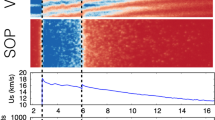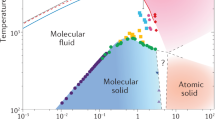Abstract
Titan's atmosphere is composed primarily of N2 with a little methane and other organic molecules. But theoretical models suggest that the initial form of nitrogen in Titan's atmosphere may have been NH3. We have investigated the possible importance of strong shocks produced during high-velocity impacts accompanying the late stages of accretion as a method for converting NH3 to N2. To simulate the effects of an impact in Titan's atmosphere we have used the focused beam of a high-power laser, a method that has been shown to simulate shock phenomena. For mixtures of 10%, 50% and 90% NH3 (balance CH4) we obtained yields of 0.25, 1, and 6 × 1017 molecules of N2 per joule, respectively. We also find that the yield of HCN is comparable to that for N2. In addition, several other hydrocarbons are produced, many with yields in excess of theoretical high-temperature-equilibrium models. The above yields, when combined with models of the satellite's accretion, result in a total N2 production comparable to that present in Titan's atmosphere and putative ocean.
This is a preview of subscription content, access via your institution
Access options
Subscribe to this journal
Receive 51 print issues and online access
$199.00 per year
only $3.90 per issue
Buy this article
- Purchase on Springer Link
- Instant access to full article PDF
Prices may be subject to local taxes which are calculated during checkout
Similar content being viewed by others
References
Lunine, J., Atreya, S. K. & Pollack, J. B. in Origin and Evolution of Atmospheres (eds Atreya, S. K., Pollack, J. B. & Matthews, M. S.) (University of Arizona Press, Tucson) (in the press).
Pollack, J. B. & Bodenheimer, P. in Origin and Evolution of Atmospheres (eds Atreya, S. K., Pollack, J. B. & Matthews, M. S.) (University of Arizona Press, Tucson) (in the press).
Prinn, R. G. & Fegley, B. Astrophys. J. 249, 308–317 (1981).
Atreya, S. K., Donahue, T. M. & Kuhn, W. R. Science, Wash. 201, 611–613 (1978).
Chameides, W. L. Nature 277, 123–125 (1979).
Lewis, J. S., Watkins, G. H., Hartmann, H. & Prinn, R. G. in Geological Implications of Impacts of Large Asteroids and Comets on the Earth (eds Silver, L. T. & Schultz, P. H.) SP-190, 215–221 (Geological Society of America, Washington, 1982).
Park, C. & Menees, G. P. J. geophys. Res. 83, 4029–4035 (1978).
Borucki, W. J. & Chameides, W. L. Rev. Geophys. Space Phys. 22, 363–372 (1984).
Chameides, W. L. & Walker, J. C. G. Origins Life 11, 291–302 (1981).
Fegley, B. Jr, Prinn, R. G., Hartman, H. & Watkins, G. H. Nature 319, 305–308 (1986).
Borucki, W. J., McKay, C. P. & Whitten, R. C. Icarus 60, 260–273 (1984).
Jones, T. D. & Lewis, J. S. Icarus 72, 381–393 (1987).
Borucki, W. J., McKenzie, R. L., McLay, C. P., Duong, N. D. & Boac, D. S. Icarus 64, 221–222 (1985).
Borucki, W. J. & McKay, C. P. Nature 328, 509–510 (1987).
Borucki, W. J., McKay, C. P., Rogers, R. S., Boac, D. S., Duong, N. D. & Parris, J. E. Appl. Opt. 26, 4319–4322 (1987).
Borucki, W. J., Giver, L. P., McKay, C. P., Scattergood, T. & Parris, J. E. Icarus (in the press).
Pollack, J. B., Podolak, M., Bodenheimer, P. & Christofferson, B. Icarus 67, 409–443 (1986).
Prinn, R. G. & Fegley, B. Earth planet. Sci. Lett. 83, 1–15 (1987).
Stevenson, D. J., Harris, A. W. & Lunine, J. I. in Satellites (eds Burns, J. A. & Matthews, M. S.) 39–88 (University of Arizona Press, Tucson, 1986).
Author information
Authors and Affiliations
Rights and permissions
About this article
Cite this article
McKay, C., Scattergood, T., Pollack, J. et al. High-temperature shock formation of N2 and organics on primordial Titan. Nature 332, 520–522 (1988). https://doi.org/10.1038/332520a0
Received:
Accepted:
Issue Date:
DOI: https://doi.org/10.1038/332520a0
This article is cited by
-
Large Ocean Worlds with High-Pressure Ices
Space Science Reviews (2020)
-
Nitrogen Atmospheres of the Icy Bodies in the Solar System
Space Science Reviews (2020)
-
Constraints from Comets on the Formation and Volatile Acquisition of the Planets and Satellites
Space Science Reviews (2015)
-
Replacement and late formation of atmospheric N2 on undifferentiated Titan by impacts
Nature Geoscience (2011)
-
Electrical Effects on Atmospheric Chemistry
Space Science Reviews (2008)
Comments
By submitting a comment you agree to abide by our Terms and Community Guidelines. If you find something abusive or that does not comply with our terms or guidelines please flag it as inappropriate.



